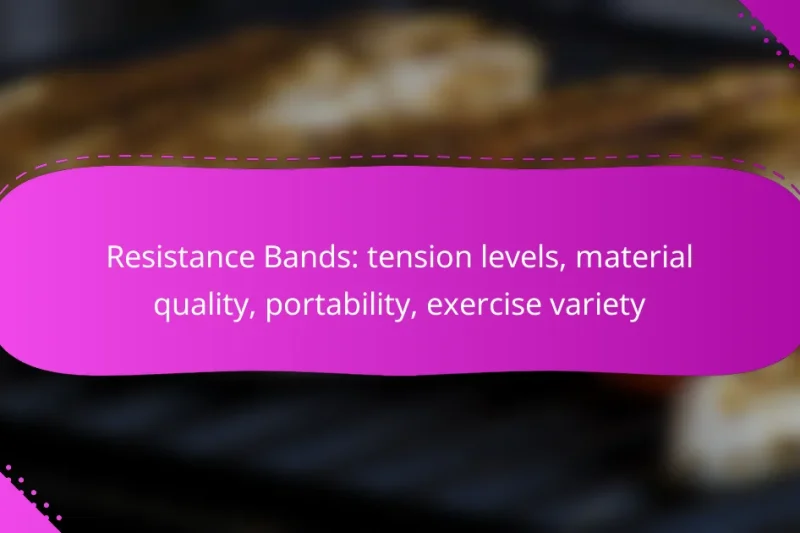Resistance bands are versatile tools for home workouts, offering a range of tension levels and material … Resistance Bands: tension levels, material quality, portability, exercise varietyRead more
Choosing the Right Fitness Equipment for Your Goals
Choosing the right fitness equipment is essential for achieving your personal health and fitness goals. Whether you’re focused on weight loss, strength training, or creating a home gym, understanding your needs and options can make all the difference. From treadmills and stationary bikes for cardio to versatile strength training tools, selecting the right gear can enhance your workout experience and results.
Stationary Bike: resistance levels, seat adjustability, display features, price
When choosing a stationary bike for home use, it’s essential to consider features like resistance levels, … Stationary Bike: resistance levels, seat adjustability, display features, priceRead more
Yoga Mat: thickness, material, grip quality, portability
Choosing the right yoga mat is essential for enhancing your practice, with thickness, material, grip quality, … Yoga Mat: thickness, material, grip quality, portabilityRead more
Ab Roller: wheel design, handle grip, size, effectiveness
The ab roller is an essential tool for strengthening your core, and its design plays a … Ab Roller: wheel design, handle grip, size, effectivenessRead more
Punching Bag: weight options, material type, hanging method, durability
Punching bags are essential training tools available in a range of weights, from lightweight options around … Punching Bag: weight options, material type, hanging method, durabilityRead more
Balance Board: stability level, material, size, training benefits
Balance boards are versatile training tools designed to enhance stability and improve core strength. Available in … Balance Board: stability level, material, size, training benefitsRead more
Jump Rope: length adjustability, handle grip, material durability, price
When selecting a jump rope, it’s crucial to consider factors such as length adjustability, handle grip … Jump Rope: length adjustability, handle grip, material durability, priceRead more
Foam Roller: density options, size, material type, portability
Foam rollers are essential tools for muscle recovery, available in a variety of densities, sizes, and … Foam Roller: density options, size, material type, portabilityRead more
Treadmill: motor power, running surface, foldability, price range
When choosing a treadmill, it’s essential to consider factors such as motor power, running surface, foldability, … Treadmill: motor power, running surface, foldability, price rangeRead more
Medicine Ball: weight options, surface texture, size, training uses
Medicine balls are versatile fitness tools available in a range of weights from 2kg to 10kg, … Medicine Ball: weight options, surface texture, size, training usesRead more
What fitness equipment is best for weight loss in Australia?
The best fitness equipment for weight loss in Australia includes treadmills, stationary bikes, and rowing machines. These options provide effective cardiovascular workouts that can help burn calories and improve overall fitness.
Treadmills
Treadmills are popular for their versatility and ease of use. They allow users to walk, jog, or run indoors, making them suitable for various fitness levels. Many models come with features like incline settings, which can increase workout intensity and calorie burn.
When choosing a treadmill, consider factors such as motor power, running surface size, and built-in workout programs. A good treadmill can range from AUD 500 to AUD 3,000, depending on the features and brand.
Stationary bikes
Stationary bikes offer an excellent low-impact cardio workout, making them ideal for those with joint concerns. They come in upright and recumbent styles, catering to different preferences and comfort levels. Regular cycling can significantly contribute to weight loss by burning calories effectively.
Look for features like adjustable resistance, built-in workout programs, and connectivity options for fitness apps. Prices for quality stationary bikes typically range from AUD 300 to AUD 2,000.
Rowing machines
Rowing machines provide a full-body workout that engages multiple muscle groups, making them efficient for weight loss. They combine cardiovascular and strength training, which can enhance calorie burning and muscle toning simultaneously.
When selecting a rowing machine, consider the resistance type (air, magnetic, or water) and the machine’s size and storage capabilities. Good rowing machines are available from AUD 400 to AUD 2,500, depending on the brand and features.
How to choose fitness equipment for strength training?
Choosing fitness equipment for strength training involves selecting tools that align with your fitness goals, available space, and budget. Consider factors such as versatility, ease of use, and the types of exercises you plan to perform.
Dumbbells
Dumbbells are a staple for strength training due to their versatility and effectiveness. They allow for a wide range of exercises targeting various muscle groups, from bicep curls to shoulder presses.
When selecting dumbbells, consider adjustable options that let you change weights easily, accommodating different exercises and strength levels. A common range for beginners is between 5 to 25 pounds, while more experienced users may opt for heavier sets.
Kettlebells
Kettlebells are excellent for dynamic strength training, combining strength and cardio in one workout. Their unique shape allows for a variety of movements, such as swings and snatches, which engage multiple muscle groups simultaneously.
When choosing kettlebells, start with a weight that feels manageable for basic exercises, typically between 8 to 16 kg for beginners. Ensure you have enough space to perform swings safely, and consider investing in a set for progressive training.
Resistance bands
Resistance bands are a cost-effective and portable option for strength training. They provide variable resistance throughout movements, making them suitable for all fitness levels and a variety of exercises.
When selecting resistance bands, look for a set with different resistance levels to match your strength progression. They are particularly useful for rehabilitation exercises and can easily be incorporated into home workouts. Avoid overstretching bands to prevent breakage and ensure safety during use.
What are the top brands for home gym equipment?
When selecting home gym equipment, several brands stand out for their quality, innovation, and user satisfaction. Bowflex, NordicTrack, and Life Fitness are among the top choices, each offering unique features and equipment types to cater to various fitness goals.
Bowflex
Bowflex is renowned for its versatile home gym systems that combine strength training with compact design. Their products, such as the Bowflex Home Gym Series, allow users to perform a wide range of exercises without taking up much space.
Consider Bowflex if you are looking for adjustable resistance options, which can accommodate different fitness levels. Their machines often feature innovative technology, such as the Bowflex SelectTech dumbbells, which allow for quick weight adjustments.
NordicTrack
NordicTrack specializes in cardio equipment, particularly treadmills and stationary bikes, known for their interactive training experiences. Their machines often come with iFit technology, providing access to a library of workouts led by professional trainers.
If you prioritize cardiovascular fitness, NordicTrack’s equipment is a solid choice. Their treadmills and bikes frequently include features like incline adjustments and touchscreens for an engaging workout experience.
Life Fitness
Life Fitness is a well-established brand in the fitness industry, offering a wide range of commercial-grade equipment suitable for home use. Their products include treadmills, ellipticals, and strength training machines, all designed for durability and performance.
Choose Life Fitness if you want gym-quality equipment at home. Their machines often come with advanced tracking features and customizable workout programs, making them ideal for serious fitness enthusiasts.
How to assess space for fitness equipment?
Assessing space for fitness equipment involves evaluating the area where you plan to place your gear to ensure it fits comfortably and safely. Consider both the dimensions of the equipment and the surrounding space needed for movement and accessibility.
Measure available area
Start by measuring the length and width of the space where you intend to set up your fitness equipment. Ensure to account for any furniture or obstacles that may restrict movement. A good rule of thumb is to leave at least 2-3 feet of clearance around each piece of equipment.
For larger items like treadmills or weight machines, consider their footprint and any additional space needed for accessories. If your area is limited, compact or multi-use equipment may be a better choice.
Consider ceiling height
Ceiling height is crucial, especially for equipment that requires overhead movement, such as pull-up bars or certain types of weight machines. Ideally, you should have at least 7-8 feet of clearance to accommodate both the equipment and the user’s movement.
In spaces with lower ceilings, opt for equipment that doesn’t require vertical space, such as stationary bikes or resistance bands, to avoid any risk of injury.
Plan for movement space
Movement space is essential for safe and effective workouts. Ensure there is enough room not just for the equipment but also for you to move freely while exercising. A minimum of 3 feet of space around the equipment is recommended for safe access and usage.
When planning your layout, visualize your workout routine to identify any additional space you may need for stretching or transitioning between exercises. Avoid overcrowding the area to maintain a comfortable workout environment.
What are the benefits of multi-functional fitness equipment?
Multi-functional fitness equipment offers several advantages, including efficient use of space, cost savings, and the ability to perform a variety of exercises. This type of equipment allows users to target multiple muscle groups and achieve diverse workout routines without needing a large number of separate machines.
Space-saving design
Multi-functional fitness equipment is designed to maximize workout capabilities while minimizing the space required. This is particularly beneficial for home gyms or smaller workout areas where floor space is limited. For instance, a compact multi-gym can combine a bench press, leg extension, and cable system in one unit.
When selecting equipment, consider models that can be easily folded or stored away when not in use. Look for options that can be adjusted to perform various exercises without taking up additional room.
Cost-effective
Investing in multi-functional fitness equipment can be more economical than purchasing several individual machines. A single unit often costs less than the combined price of separate equipment for each exercise. For example, a multi-station gym may range from a few hundred to a couple of thousand dollars, depending on features and quality.
Additionally, this type of equipment often requires less maintenance and fewer replacement parts, which can lead to long-term savings. Always compare warranties and customer reviews to ensure you are making a wise investment.
Versatile workouts
Multi-functional fitness equipment allows for a wide range of exercises, making it easier to create varied workout routines. Users can perform strength training, cardio, and flexibility exercises all on one machine. This versatility helps prevent workout monotony and keeps users engaged.
To maximize the benefits, consider incorporating different types of workouts into your routine, such as circuit training or high-intensity interval training (HIIT). This approach can enhance overall fitness and help achieve specific goals more effectively.
How to compare fitness equipment warranties?
When comparing fitness equipment warranties, focus on the duration and coverage of the warranty. A longer warranty often indicates better quality, while comprehensive coverage protects against various issues.
Understand the warranty duration
The warranty duration typically varies by equipment type and manufacturer. Most warranties range from one to several years, with some high-end machines offering lifetime coverage on certain parts. Consider how long you plan to use the equipment and choose a warranty that aligns with your expected usage.
For example, if you are purchasing a treadmill, look for warranties that cover at least 2-3 years on parts and 1-2 years on labor. This ensures you are protected against potential defects during the initial years of use.
Check what is covered
Not all warranties are created equal; some cover only specific parts, while others may include labor costs or offer full replacement options. Review the warranty details to understand what components are included, such as the frame, motor, and electronics.
For instance, a warranty that covers the frame for a lifetime but only the motor for one year may not be as beneficial if you anticipate heavy use. Look for warranties that provide comprehensive coverage to safeguard your investment.
Consider the warranty terms
Warranty terms can include conditions that may affect your coverage, such as maintenance requirements or usage limitations. Some manufacturers require regular servicing or specific usage guidelines to keep the warranty valid.
Before purchasing, read the fine print to avoid surprises. For example, if a warranty states that it is voided by commercial use, ensure your intended use aligns with the warranty terms.









